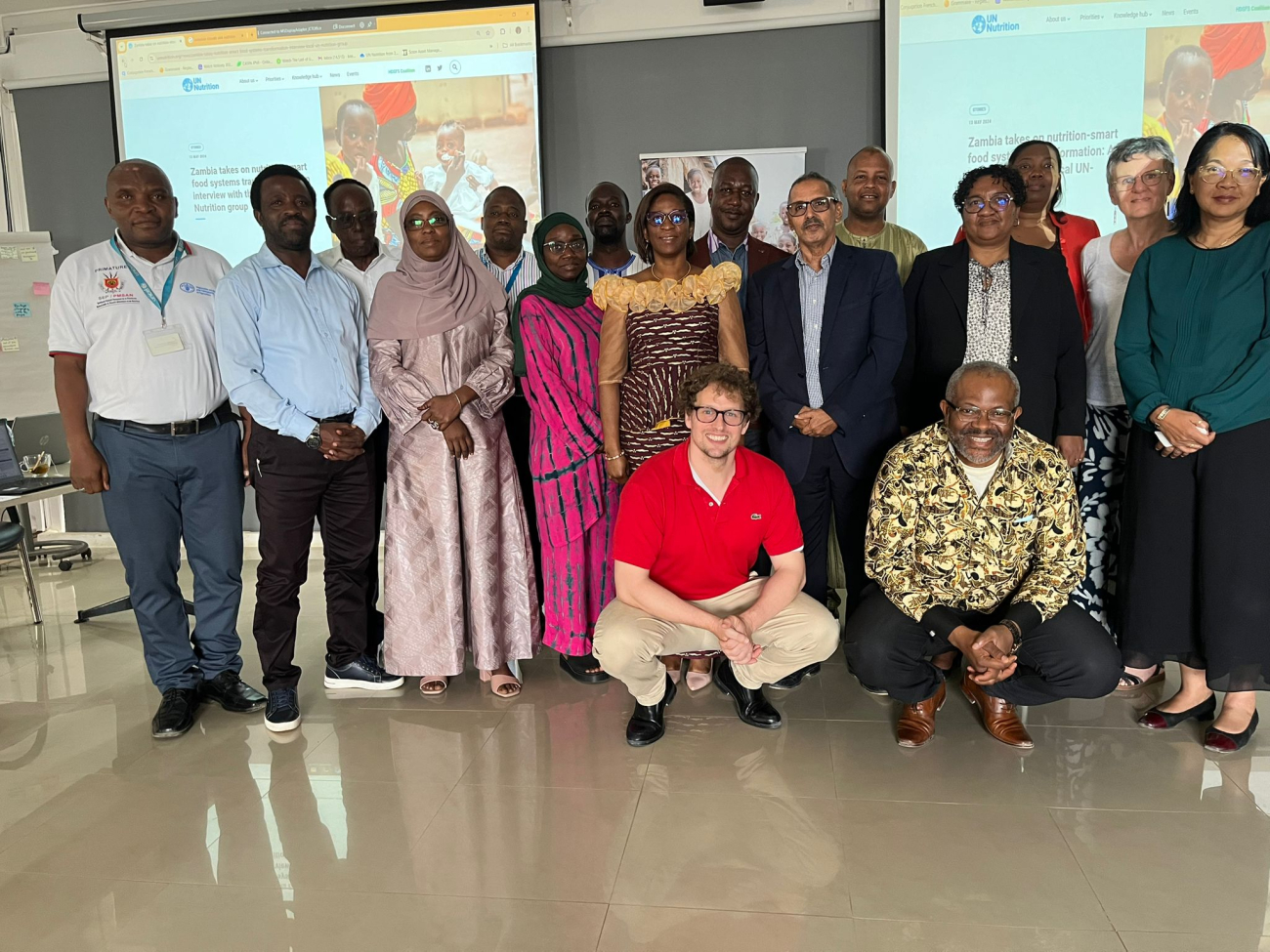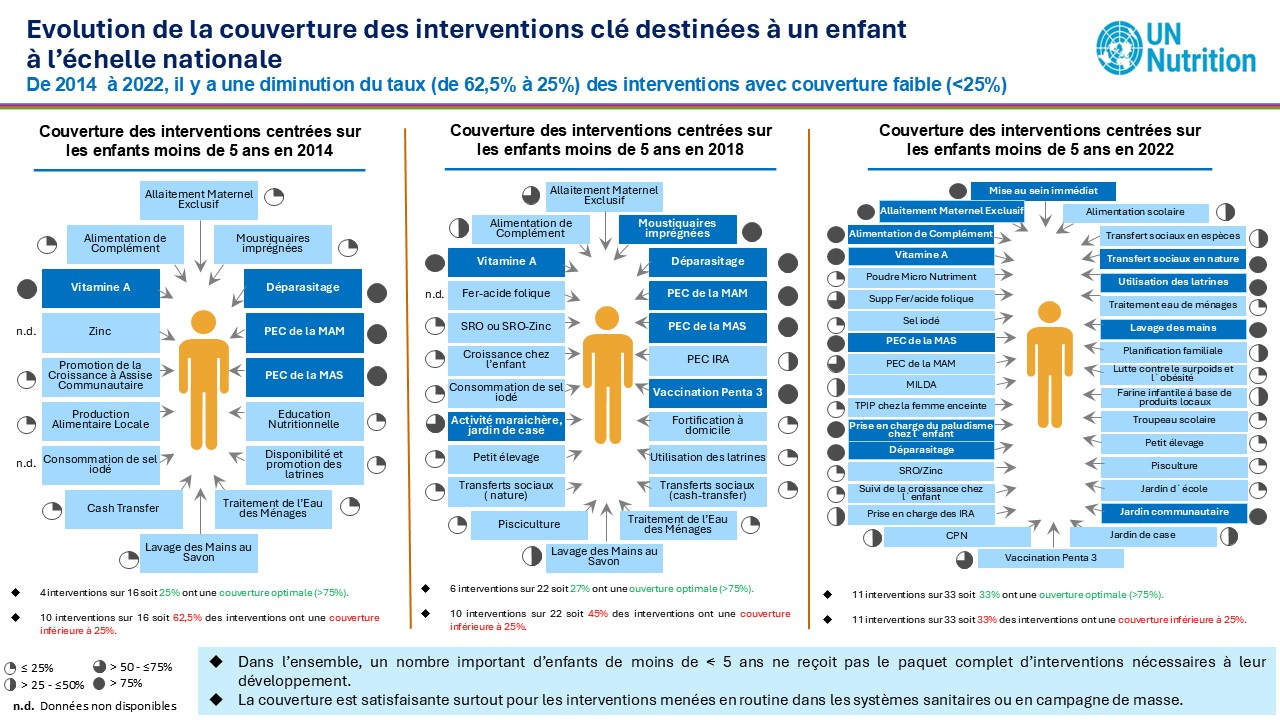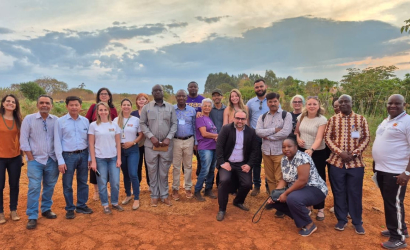Introduction
About fifteen years ago, experts from the international nutrition community teamed up with organizational change experts from the private sector to develop analytics in response to fragmentation – the Achilles heel of the field. The methodologies cover the full multisectoral nutrition landscape, giving a bird’s eye view of the situation at country level. Furthermore, the analytics help governments better coordinate nutrition actions across stakeholders with over 30 countries having benefitted from them – from the Republic of the Union of Myanmar to the Republic of Haiti (herein Haiti). Some countries have even conducted multiple rounds of analysis in an effort to track progress over time. With present overlapping crises threatening nutrition and eroding government budgets for social programmes, tools that countries can utilize to support evidence-based decision-making and efficient allocation of resources are all the more pertinent.
Critical reflection
As part of the support to the UN-Nutrition collective, the UN-Nutrition Secretariat thought it opportune to pause for learning. The time was ripe given the continued flux of country requests for these analytics and current resource squeeze. A workshop was subsequently organized with the Scaling Up Nutrition (SUN) Movement Regional Hub for West Africa, recognizing the ability of the tools to galvanize actors from different parts of the SUN Movement. This also helped meet country demand for peer-to-peer learning, particularly from the Francophone nutrition community. The workshop was open to all French-speaking UN-Nutrition country teams in Africa (plus Haiti), other members of SUN country multi-stakeholder platforms, the SUN Movement Secretariat and national food systems convenors.
Colleagues from the Food and Agriculture Organization of the United Nations (FAO), the United Nations Children’s Fund (UNICEF) and the World Food Programme (WFP) and government officials from seven countries (Burkina Faso, the Republic of Burundi, the Republic of Chad [herein Chad], the Republic of Côte d'Ivoire [herein Côte d’Ivoire], the Democratic Republic of the Congo [DRC], the Republic of Madagascar and the Republic of the Niger [herein the Niger]) gathered in person in Dakar, Senegal to partake in what proved to be a vibrant exchange. They were joined briefly by the UNICEF Regional Director, Gilles Fagninou, who was keen to hear about how UN agencies are collaborating on nutrition in West and Central Africa.

The main objective of this two-day workshop was to take stock of recent experiences with UN-Nutrition tools and services to address the challenges of coordination between different stakeholders in Francophone Africa. Some of the participants (e.g. from Burkina Faso, Chad, Côte d’Ivoire, DRC) were about to embark on successive rounds of data collection for the analytical exercises and eager to pick up tips from other countries. Held on 18–19 June 2024, it was the first moment of reflection since an impact assessment of the tools was undertaken in 2019 under the auspices of the UN Network for SUN (one of the two predecessors of UN-Nutrition).
Seizing the moment
Before delving into the details, the tools were contextualized within UN-Nutrition’s wider country support services. This initial session, which was open for virtual participation, was grounded in the UN-Nutrition strategy. Among other highlights, it touched upon how the Secretariat links global momentum (e.g. around food systems transformation, the Nutrition for Growth summits) to country-level coordination initiatives. It also included a presentation on the UN-Nutrition guidance note for integrating nutrition into the United Nations Sustainable Development Cooperation Framework (UNSDCF). The proceedings were moderated by members of the UN-Nutrition Secretariat, who asked incisive questions to structure the exchange and help maximize learning opportunities. For instance: How can planning processes for the mapping exercise be improved to be more effective and inclusive? Which part(s) of the guidance note do you find most useful for your current phase of the UNSDCF cycle? The workshop thus provided a forum for peer learning and open discussions about the strengths and weaknesses of UN-Nutrition country support modalities with a mix of interactive groupwork and country presentations.

Zooming in on three resources
The UN-Nutrition toolkit is comprised of five analytics: the Multi-sectoral Nutrition Overview; the Policy and Plan Overview; the Nutrition Stakeholder and Action Mapping; the Nutrition Capacity Assessment; and the UN-Nutrition Inventory. They are complemented by the UNSDCF guidance note, released by UN-Nutrition in 2023. All these resources provide an avenue for strengthening UN collaboration on nutrition and partnership with other stakeholders to animate the multisectoral approach. While they can be used separately, they can also be used in conjunction with one another (and other tools). For example, findings from the UN-Nutrition Inventory can be leveraged to help integrate and strengthen how nutrition is reflected in UN cooperation frameworks. Nevertheless, the Dakar workshop focused on three of these resources, namely: the mapping; the inventory; and the guidance note on integrating nutrition into UNSDCFs.
The discussions took on a very practical flavour. Participants shared how these resources have contributed to policy, joint UN planning and programming, and other decision-making processes. For example, the analytics (including the mapping and inventory exercises) triggered the development of a 4-year common UN Agenda on Nutrition and the formulation of joint programmes, such FORMA-NUT and PRO-FORT (Production Locale d’Aliments de Complément Fortifiés) in Chad. Amina Bagnou at Niger’s High Commission of the 3N Initiative (les Nigériens nourrissent les Nigériens), is a veteran of the mapping tool, having coordinated multiple rounds of the process in Niger as well as the initial exercises in three other countries in the region. In her view, the mapping is a powerful tool, and she was proud to share how it informed the development of nutrition advocacy materials, the development of the National Nutrition Security Policy (2016–2025) and its costed action plans, the inclusion of nutrition in the country’s Economic and Social Development Plan and the establishment of the National Information Platform for Nutrition (NIPN). She also explained that “the mapping is contributing to better monitoring and evaluation of the implementation of the national nutrition policy and increasing mutual accountability of all stakeholders.” Exposing coverage gaps, has prompted nutrition actors to increase their reach over the 8-year span between the first and latest rounds of mapping completed in 2014 and 2022, respectively (see figure below).

There was a general sense among participants that repeating the mapping exercise at regular intervals is a ‘good practice’. Another tip discussed was to sequence the mapping just before the development of a national nutrition plan, donor roundtables or the Common Country Analysis phase of the UNSDCF so that provisions can be included in those to address coverage shortfalls. Furthermore, participants reflected on opportunities for using these tools, both to sharpen the nutrition lens in food systems transformation that countries are pursuing in parallel and to help bridge the two workstreams.
Take-aways and collective learning
“The hunger for the exchange with peers was evident from the start with active participation from everyone and engaging inputs from the countries present,” noted Kate Ogden of the UN-Nutrition Secretariat when reflecting on the workshop. Participants acknowledged that learning from good practices in other countries is one strategy they can employ to address bottlenecks. They also realized that they face the same hurdles in many respects, but that different approaches can be used to overcome them. Odile Michèle Randriamananjara from Madagascar picked up pointers from the Chad experience, which she plans to apply to the Malagasy setting. One of these is ensuring the involvement of the heads of agencies in the joint UN-Nutrition workplan. Odile Michèle was inspired to hear that her counterpart in Chad has regular meetings with the Country Representatives of Members Agencies and direct interaction with the United Nations Resident Coordinator (UNRC). One concrete way of engaging UN senior management at country level is to present the findings from the analytics to the Heads of Agencies and the UNRC. This helps sensitize them on the meaningfulness of these tools, foster UN collaboration and elevate nutrition on the national political agenda. In Chad, this has the added advantage of helping to value UN-Nutrition as an inter-agency coordination mechanism. Hearing about these experiences leads her to believe that establishing, “a Francophone exchange system through UN-Nutrition would be desirable well beyond the ‘mapping’ theme.” Other participants shared this sentiment, suggesting the reinstatement of routine conference calls between the UN-Nutrition Secretariat and in-country facilitators, where colleagues can share updates and seek support.
Another recommendation emanating from the Dakar workshop was to share good practices about the mapping exercise at the 2024 SUN Movement Global Gathering in November. Furthermore, participants found the UN-Nutrition Inventory tool to be useful for identifying thematic and geographic areas for increased synergy among Member Agencies. Despite the popularity of the two tools, funding to support their use at country level is a challenge, particularly against today’s backdrop of constrained resources. Greater backing among senior UN representatives might help alleviate funding pressures, at least in part. Likewise, participants believe that increasing visibility to the work UN-Nutrition is carrying out at the country level could be helpful. Participants also voiced that they could benefit from further guidance on how to apply the UNSDCF guidance note and undertake other UN-Nutrition analytics, such as the Multi-sectoral Nutrition Overview. These are just some of the takeaways from this fruitful workshop.
Moving forward and conclusion
Overall, the workshop helped connect colleagues working at the country level and catalyse future exchanges. For example, a three-country exchange between Burkina Faso, Chad and Côte d’Ivoire will take place on 25th September to foster further learning from the mapping exercise across borders. In addition, the outcomes of the workshop will inform future UN-Nutrition support, substantiating the inclusion of regular meetings with countries and efforts to refine the tools in the Secretariat’s next workplan. The UN-Nutrition Secretariat is already in the process of holding follow-up calls with country focal points based on their collective responses to a recent survey to better understand their technical assistance needs, bottlenecks and future priorities. It is also working to organize a segment on the analytical tools at one of the ‘charging stations’ at the forthcoming SUN Global Gathering. The attraction will engage countries which have undertaken those exercises and show how they mobilize stakeholders across sectors. Furthermore, the Secretariat is exploring how to highlight the new UNSDCF guidance in a dedicated UN-Nutrition session to be held on the eve of the SUN Global Gathering. These are some of the measures that UN-Nutrition is taking to bolster coherent nutrition policy and integrated nutrition planning, as it strives for continuous improvement in the way it supports countries tackle their multifaceted nutrition challenges and accelerate coordinated action.



